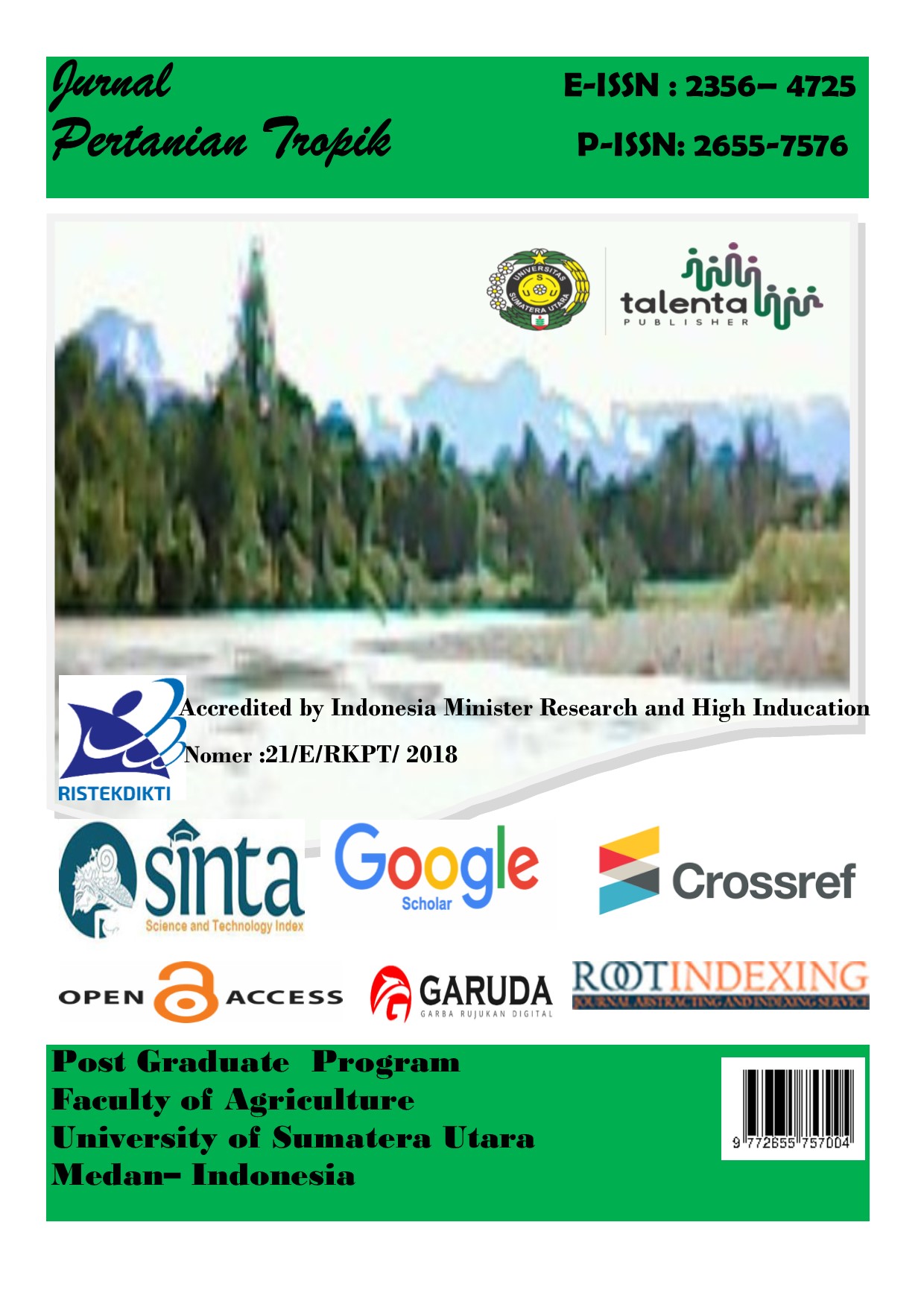PRIMARY METABOLITE QUALITATIVE TEST OF BINTARO PLANT (CarberaodollamGaertn) AS A PEST BIOPESTICIDE Rattus argentiventer
DOI:
https://doi.org/10.32734/jopt.v7i3.4998Keywords:
Bintaro, primary metabolites content, Rattus argentiventerAbstract
Abstract
Bintaro is a plant that contains poison in all parts of the plant. Cardiac glycoside compounds contained in Bintaro plants can be used as biopesticides to repel rats. Rat pests are one of the important pests in rice plants that are difficult to control, so rice production always decreases. Therefore it is necessary to look for an effective, efficient and environmentally friendly control technology, namely by using Bintaro plant extracts which are able to become biopesticides to repel rat pests. The purpose of this study was to determine the primary compound of the Bintaro plant (CarberaodollamGaertn) which acts as a repellent for thepest Ratusargiventer. The method used in this research is qualitative testing using phenol method to test the content of primary metabolites in the leaves and stems of Bintaro plants. From the results of the research conducted, it was found that the qualitative levels of primary metabolites from Bintaro leaves and stems contained protein content. Fat and carbohydrate content.
Downloads
References
Anurag, K., Irchaiya, R., Yadaf, A., Gupta, N., Kumar, S., Prakash, A., and Gurjar, H. (2015). Metabolites in plants and its classification. World Journal of Pharmacy and Pharmaceutical Sciences, 4(1), 287-305
Aldywaridha. 2010. Uji efektivitas insektisida botani terhadap hama Maruca testulalis (Geyer) (Lepidoptera; Pyralidae) pada tanaman kacang panjang (Vigna sinensis). Jurnal Ilmiah Abadi, 3(2): 449-458
Apriantono, A., Dedi, F., Puspitasari, N., Sedarmawati & Slamet, B. (1988). Analisis pangan. Bandung: ITB.
Bintang, M. 2010 Biokimia Teknik Penelitian. Erlangga. Jakarta
Handoko, T. Suhandiaya, G. Mulyana, H. 2012. Hidrolisis Serat Selulosa Dalam Buah Bintaro Sebagai Sumber Bahan Baku Bioetanol. Jurnal Teknik Kimia Indonesia, Volume 11 No 1 (2012), halaman 26-33. Universitas Parahiyangan. Bandung
Harborne, J. B. (1987). Metode fitokimia penentuan cara modern menganalisis tumbuhan. Bandung: ITB.
Hermiati, Rusli, Manalu, N. Y., & Sinaga, M. S. (2013). Ekstrak daun sirih hijau dan merah sebagai antioksidan pada minyak kelapa. Departemen Teknik Kimia, Fakultas Teknik, Universitas Sumatera Utara, 2(1).
Juniaty Towaha dan Gusti Indriati. 2011. Potensi Tanaman Bintaro (Cerbera Manghas) Sebagai Alternatif Sumber Bahan Bakar Nabati. Warta Penelitian Dan Pengembangan Tanaman Industri. Volume 17 Nomor 1, April 2011. ISSN 0853-8204
Kuddus, M.R., Rumi, F., & Masud, M.M., 2011, Phytochemical Screening and Antioxidant Activity Studies of Cerberaodollam Gaertn. International Journal of Pharma and Bio Sciences, 2(1), 413-418
Kurratul A, Betty L dan Balqis. 2014. Skrining Fitokimia dan Penentuan Aktivitas Antioksidan Serta Kandungan Total Fenol Ekstrak Buah Labu Siam (Sechium edule (jacq.) Sw.). Diploma Thesis, Universitas Negeri Malang.
Prayuda, Y.E. 2014. Efikasi Ekstrak Biji Bintaro (Cerberamanghas) Sebagai Larvasida pada Larva Aedes aegypti LInstar III/ IV. Program Studi Pendidikan Dokter Fakultas Kedokteran dan Ilmu Kesehatan UIN Syarif Hidayatullah Jakarta.
Rismawati, 2011. Informasi Singkat Benih. Sulawesi. No.121.
Rohimatun; Suriarti, Sondang. 2011. Bintaro (Cerberamanghas) Sebagai Pestisida Nabati: Warta Penelitian dan Pengembangan Tanaman Industri; ISSN 0853-8204, Bogor, IPB, Hal 1-4.
Utami S,L. Syaufina dan N. F. Haneda. 2010. Daya racun ekstrak kasar daun bintaro (Cerbera odollam Gaertn.) terhadap larva Spodoptera litura fabricius. Jurnal Ilmu Pertanian Indonesia.15 (2): 96-100.
Downloads
Published
How to Cite
Issue
Section
License
Copyright (c) 2020 Jurnal Pertanian Tropik

This work is licensed under a Creative Commons Attribution-ShareAlike 4.0 International License.






















